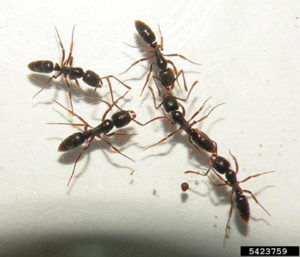Asian Needle Ants Found in NC
go.ncsu.edu/readext?1077842
en Español / em Português
El inglés es el idioma de control de esta página. En la medida en que haya algún conflicto entre la traducción al inglés y la traducción, el inglés prevalece.
Al hacer clic en el enlace de traducción se activa un servicio de traducción gratuito para convertir la página al español. Al igual que con cualquier traducción por Internet, la conversión no es sensible al contexto y puede que no traduzca el texto en su significado original. NC State Extension no garantiza la exactitud del texto traducido. Por favor, tenga en cuenta que algunas aplicaciones y/o servicios pueden no funcionar como se espera cuando se traducen.
Português
Inglês é o idioma de controle desta página. Na medida que haja algum conflito entre o texto original em Inglês e a tradução, o Inglês prevalece.
Ao clicar no link de tradução, um serviço gratuito de tradução será ativado para converter a página para o Português. Como em qualquer tradução pela internet, a conversão não é sensivel ao contexto e pode não ocorrer a tradução para o significado orginal. O serviço de Extensão da Carolina do Norte (NC State Extension) não garante a exatidão do texto traduzido. Por favor, observe que algumas funções ou serviços podem não funcionar como esperado após a tradução.
English
English is the controlling language of this page. To the extent there is any conflict between the English text and the translation, English controls.
Clicking on the translation link activates a free translation service to convert the page to Spanish. As with any Internet translation, the conversion is not context-sensitive and may not translate the text to its original meaning. NC State Extension does not guarantee the accuracy of the translated text. Please note that some applications and/or services may not function as expected when translated.
Collapse ▲Cherokee County residents, it’s time to get acquainted with a new — and potentially problematic — neighbor: the Asian needle ant. While you might be used to seeing various ants scurrying around, this invasive species is gaining attention across North Carolina, including in our mountain areas, for its painful sting and ecological impact.

Asian needle and workers
According to experts at NC State Extension, the Asian needle ant ( Brachyponera chinensis ) is a distinct threat that differs from many other common ants. First identified in the U.S. in the 1930s, it’s only in recent years that its presence and potential impact have become widely recognized, particularly in the Southeast.
Unlike some of our more aggressive native ants or notorious invaders like fire ants, Asian needle ants aren’t typically found in massive, obvious mounds. They’re often seen roaming individually or in loose groups, making them easy to overlook.
Highlights about this ant:
- Appearance: They are medium-to-small in size, typically around 1/5 inch long. Their bodies are dark brown to black, with legs and mandibles (mouthparts) that are a lighter, often orange-ish brown. A key identifying feature is their prominent stinger that protrudes from their rear abdomen.
- Unique Behavior: One interesting trait that sets them apart is their inability to cling to smooth surfaces like glass. If you were to capture one in a glass jar, you’d observe it making futile attempts to climb the sides before settling at the bottom.
- Habitat Preferences: These ants prefer moist, damp environments. You’re likely to find their nests in places like rotting logs, leaf litter, under rocks, in loose soil, and even within man-made structures like around sprinkler systems or pavement cracks. Unlike many pest ants that thrive in disturbed areas, the Asian needle ant can also establish colonies in “natural areas” like forests.
- Painful Sting with Allergic Potential: True to its name, the sting of an Asian needle ant can be quite painful, often described as a sharp prick followed by a burning sensation. More concerning is the fact that their venom is, on average, more likely to cause an allergic reaction than a honey bee’s sting. For individuals prone to severe insect sting allergies, an Asian needle ant sting could lead to anaphylaxis, a serious medical emergency. Most stings occur when people accidentally place their hands on or near a nest, or when an ant gets trapped against their skin.
- Sneaky Home Invaders: While their colonies are generally smaller than those of highly common house pests, Asian needle ants are increasingly being found scavenging for food in residential kitchens and school cafeterias. While the sight of ants on food is a nuisance, the primary concern here is the increased risk of stings.
- Threat to Native Ecosystems: This is perhaps their most significant long-term impact. Asian needle ants are predatory, with a preference for termites, but they also prey on native ant species and other invertebrates. By outcompeting or directly consuming native ants, they disrupt crucial ecological roles like seed dispersal and the predation of forest pests, potentially throwing off the delicate balance of our local ecosystems.
If you suspect you have Asian needle ants on your property follow these recommendations:
- Identification: Confirming it’s an Asian needle ant is the first step. Look for the distinct features mentioned above, including their inability to climb glass.
- Careful Management: They are not aggressive like fire ants, but they will sting if pressured or threatened. If one lands on you, it’s best to flick it off rather than brush it. Wear gloves when gardening or handling yard debris, especially in moist, shady areas where they might nest.
- Professional Help: While protein-based insecticide baits have shown some promise in management, there isn’t a universally formalized treatment protocol for eradication. For effective control, it’s often best to consult with a local pest management professional who can accurately identify the ant and recommend targeted strategies.




